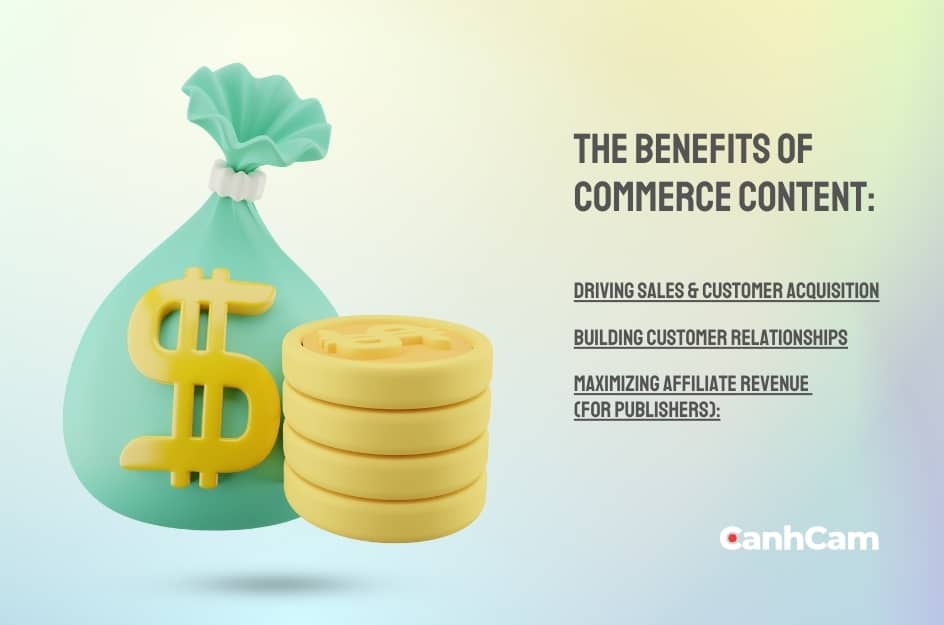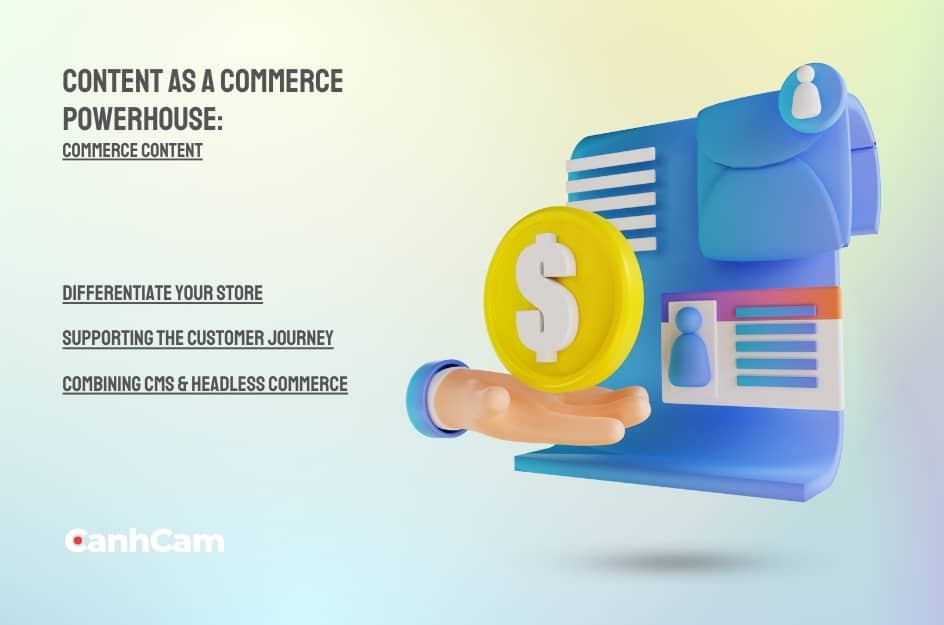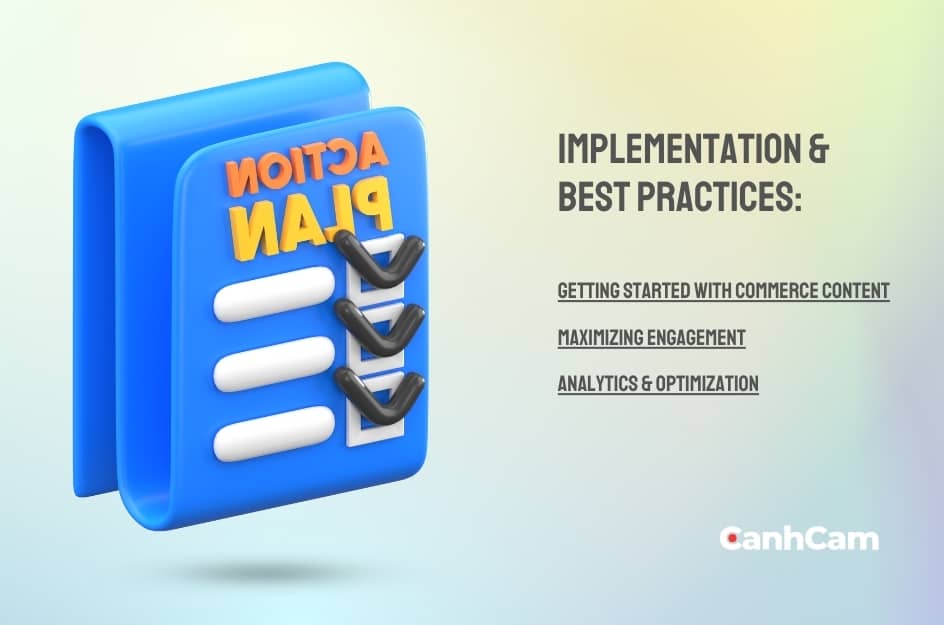Did you know that commerce content is transforming the way consumers interact with brands online? Commerce content has appeared as a vital tool in influencing consumer behavior and driving sales.
Understanding commerce content can be the key to success. But, How do you apply it to your ecommerce business, and How do you build high-quality content? Let's find out.
What is Commerce Content?
Commerce content refers to any type of content, such as articles, blog posts, videos, or social media posts, that is created with the point of promoting or selling products or services. This content typically includes product recommendations, reviews, comparisons, and buying guides focused on consumers' purchasing decisions. However, creators and publishers need to maintain transparency and disclose any relationships with brands or advertisers to ensure honest and trustworthy content creation.
Commerce Content in Action:
Check out how commerce content works in action! It comes in different shapes like product reviews, influencers saying they love something, and articles you can shop from. Think of a fashion blogger sharing their top outfits with links to buy them - that's mixing content with shopping right there. Also, those guides comparing products and tutorials teaching you things while hinting at what to buy are pretty good at helping you decide what to get.
Visit Our Service: Website Design Cost Melbourne

How does Commerce Content work?
To answer this question, we've got three main groups involved — brands, agencies, and publishers need to pay attention. Here's why content commerce is super crucial.
Who's in the Mix
Commerce content brings together a mix of players, like brands, agencies, publishers, and content creators. Brands use this content to connect with their audience and boost sales. Agencies help brands team up with content creators. Publishers make money through affiliate marketing deals using commerce content, creating a win-win for creators and brands.
Improve your content skill? Find-out: Tips to Increase for Ecommerce Copywriter
Crafting Content
To nail great commerce content, you need a smart strategy involving teamwork, creativity, and knowing your audience. Content creators dig deep to understand what consumers want and need, making sure their content hits home with the right crowd. From brainstorming to sharing, the process focuses on being real and on point, driving up interaction and sales in the end.
Building Your Commerce Content Strategy:
Crafting a Commerce Content Strategy equips you to attract and engage customers through informative, valuable content. By understanding your audience's needs, you can create content that guides them through the buying journey, ultimately boosting sales and brand loyalty.
Different Ways to Present Products
A good strategy for showcasing products includes using different formats like reviews, guides, videos, and interactive content. Each format appeals to different consumer preferences and behaviors, helping brands offer a variety of content to engage their audience. For instance, videos demonstrating products can be a great way to show off what a product can do while catching the viewer's eye.

Commerce Content vs Sponsored Content
Commerce and sponsored content aim to promote products, but they go about it differently. Commerce content smoothly weaves product promotion into valuable content, giving consumers real value while boosting sales. On the side, sponsored content involves brands paying publishers or influencers to create promotional material, sometimes with less focus on authenticity and independence.
Incorporating Commerce Content
To successfully combine commerce content into your marketing plan, you need to plan and execute carefully. Brands should create content that reflects their identity and values while offering useful information to consumers.
By seamlessly integrating commerce content across platforms like social media, email, and websites, brands can effectively connect with their target audience and drive sales.
In the next section, we'll explore the benefits of commerce content and how it can transform your online presence.
The Benefits of Commerce Content:
Commerce content does more than sell. It educates, builds trust, and drives sales. Expect benefits like higher conversions, loyal customers, and better SEO. It's content that converts!
Driving Sales & Customer Acquisition:
One of the primary benefits of commerce content is its ability to drive sales and attract new customers. By providing valuable information and recommendations, commerce content can influence purchasing decisions and encourage consumers to make informed choices.
Whether through product reviews, buying guides, or exclusive deals, compelling content can significantly impact conversion rates and revenue generation for businesses.

Building Customer Relationships:
Commerce content plays a crucial role in fostering trust and building long-term relationships with customers. By delivering high-quality, relevant content that addresses consumer needs and interests, brands can establish themselves as authorities in their respective industries. Additionally, engaging with customers through interactive content and social media platforms allows brands to strengthen connections and cultivate loyalty among their audience.
Maximizing Affiliate Revenue:
For publishers and content creators, commerce content presents a lucrative opportunity to monetize their platforms through affiliate marketing. By strategically incorporating affiliate links within their content, publishers can earn commissions for driving sales to partner brands. However, it's essential to maintain transparency and disclose affiliate partnerships to ensure trust and credibility with your audience.
Advantages of Content Commerce:
Content ecommerce uses valuable content to draw in customers, educate them, and drive sales. It strengthens SEO, builds trust, and smooths the buying journey.
Differentiate Your Store:
In a crowded e-commerce landscape, content can serve as a powerful tool to differentiate your online store from competitors. By creating compelling product descriptions, blog posts, and multimedia content, brands can showcase their unique value proposition and engage customers on a deeper level. Investing in high-quality content not only enhances brand visibility but also sets the stage for increased conversions and customer retention.
Supporting the Customer Journey:
Effective commerce content caters to consumers at every stage of the purchasing journey, from awareness to decision-making. By delivering informative and engaging content across multiple touchpoints, brands can guide prospects through the sales funnel and address their specific needs and concerns. Whether through educational blog posts, interactive quizzes, or personalized recommendations, content plays a pivotal role in shaping the customer experience.

Combining CMS & Headless Commerce:
The integration of content management systems (CMS) with headless commerce platforms offers unparalleled flexibility and scalability for brands. By decoupling the front-end presentation layer from the back-end commerce functionality, businesses can deliver personalized content experiences across various channels and devices. This headless approach enables seamless content delivery, dynamic updates, and enhanced user engagement, ultimately driving conversions and revenue.
Disadvantages of Content Commerce:
Content ecommerce, though innovative, has drawbacks. Creating high-quality content and standing out in a crowded space requires investment. Measuring success beyond sales and keeping content fresh can be challenging. Additionally, content may not be ideal for all products.
Navigating Complexity:
Implementing a commerce content strategy can present various challenges, including content production costs, resource constraints, and competing priorities. Brands must navigate the complexities of balancing promotional content with valuable, informative material to maintain audience trust and engagement.
Additionally, managing affiliate partnerships and tracking performance metrics can be time-consuming and require ongoing optimization efforts. By addressing these challenges proactively and adopting a strategic approach, brands can overcome obstacles and maximize the effectiveness of their commerce content initiatives.
Ensuring Compliance:
Legal and ethical considerations are paramount when engaging in commerce content practices, particularly regarding claims, disclosures, and affiliate marketing practices. Brands must adhere to industry regulations and guidelines, including FTC disclosure requirements for sponsored content and affiliate marketing partnerships.
Transparently disclosing relationships with brands and accurately representing product benefits and features is essential to maintain credibility and trust with consumers. Prioritizing ethical business practices and compliance ensures a positive reputation and long-term success in the competitive e-commerce landscape.
In the next section, we'll delve into implementation strategies and best practices for launching a successful commerce content strategy.
Implementation & Best Practices:
"Implementation & Best Practices" is about putting a plan into action and following recommended methods for success. It's about doing it right, from launch to ongoing management.
Getting Started with Commerce Content:
Launching a commerce content strategy requires careful planning and execution. Start by defining your objectives, target audience, and key performance indicators (KPIs). Conduct market research to identify trending topics, consumer preferences, and competitive insights.
Then, develop a content calendar outlining your content themes, formats, and distribution channels. Collaborate with internal teams or external partners to create high-quality content that resonates with your audience and aligns with your brand identity.

Maximizing Engagement:
To maximize user engagement with your commerce content, incorporate interactive elements and user-generated content (UGC). Encourage audience participation through polls, quizzes, and contests, allowing users to interact with your brand in meaningful ways.
Additionally, leverage UGC by showcasing customer testimonials, reviews, and user-generated photos or videos. User-generated content not only enhances authenticity but also fosters a sense of community and belonging among your audience.
Analytics & Optimization:
Measuring the success of your commerce content efforts is essential for optimizing performance and driving continuous improvement. Utilize web analytics tools to track key metrics such as website traffic, engagement rates, and conversion rates.
Analyze user behavior and content performance to identify areas for optimization and refinement. A/B tests different content formats, headlines, and calls to action to determine what resonates best with your audience. By leveraging data-driven insights, you can refine your content strategy and maximize ROI.
Emerging Trends in Commerce Content:
Key trends include personalization, AI for recommendations, AR for product visualization, and video demos. Interactive experiences and storytelling are hot, with user-generated content and mobile-friendly design crucial for success.
Personalized Content Commerce:
Personalization is shaping the future of commerce content, allowing brands to deliver tailored experiences to individual consumers. Leverage data analytics and AI-driven technologies to segment your audience and deliver personalized recommendations, product suggestions, and content experiences. By understanding each customer's preferences, behaviors, and purchase history, brands can create hyper-targeted content that resonates on a personal level, driving engagement and conversions.
SEO Integration:
Optimizing your commerce content for search engines is essential for enhancing its visibility and reach. Conduct keyword research to identify relevant search terms and topics within your niche. Incorporate target keywords naturally within your content, including in headlines, meta descriptions, and alt tags.

Focus on creating high-quality, informative content that addresses user intent and provides value to your audience. Additionally, optimize your website's technical aspects, such as site speed, mobile responsiveness, and structured data markup, to improve search engine rankings and drive organic traffic.
Video Commerce Examples:
Video content is becoming increasingly popular in e-commerce, offering immersive and engaging experiences for consumers. Platforms like TikTok and YouTube provide opportunities for brands to showcase products through shoppable video integration. Create compelling video content that highlights product features, benefits, and use cases in a visually appealing format.
Incorporate interactive elements such as clickable links and CTAs to drive viewers to purchase directly from the video. By harnessing the power of video commerce, brands can captivate audiences and drive conversions dynamically and compellingly. In the following section, we'll address the challenges and considerations associated with implementing a commerce content strategy, as well as provide a conclusion summarizing the key takeaways and benefits of commerce content.
Conclusion:
In short, commerce content is a great tool for brands, publishers, and creators to boost sales, connect with customers, and stand out online. By making awesome content that smoothly includes product promotion, businesses can bring in new buyers, build loyalty, and make more money. But doing well in this area means planning carefully, executing strategies smartly, and always improving.
To really succeed, keep up with new trends, use data insights, and stick to ethical practices. This way, brands can fully benefit from commerce content to meet their goals and beat the competition. When you dive into commerce content, focus on quality, being real, and putting customers first. You'll see your content become a key player in driving growth and success in the changing world of online shopping.

